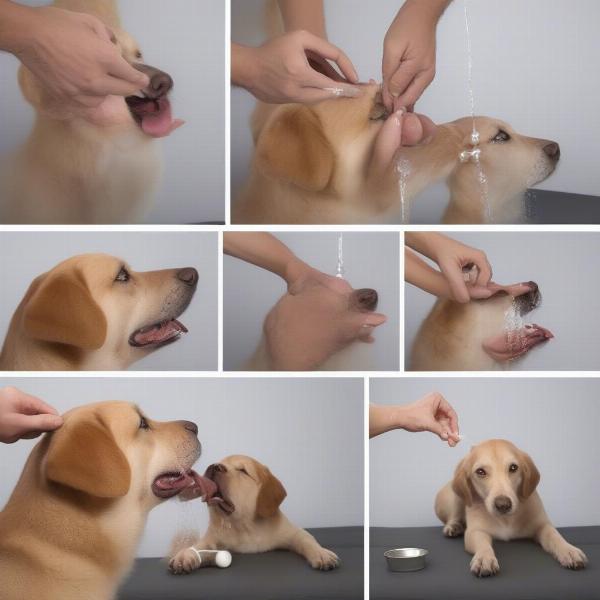Eye drops for dogs are a common treatment for various eye conditions, ranging from minor irritations to serious infections. Understanding when and how to use them is crucial for every dog owner. Choosing the right eye drops and administering them correctly can significantly impact your dog’s eye health and overall well-being. This guide will provide you with all the essential information you need to know about using eye drops for your canine companion.
Common Reasons Why Dogs Need Eye Drops
Dogs can require eye drops for a variety of reasons, including:
- Infections: Bacterial, viral, or fungal infections can cause redness, discharge, and discomfort.
- Allergies: Environmental allergens like pollen or dust can lead to itchy, watery eyes.
- Dry Eye: Also known as Keratoconjunctivitis Sicca (KCS), this condition results in insufficient tear production, causing dryness and irritation.
- Injuries: Scratches, foreign objects, or trauma can necessitate eye drops to prevent infection and promote healing.
- Glaucoma: This serious condition involves increased pressure within the eye and often requires specialized eye drops.
- Cataracts: While not directly treated with eye drops, some drops can help manage related inflammation or discomfort.
Choosing the Right Eye Drops for Your Dog
Never administer human eye drops to your dog without consulting a veterinarian. Human eye drops can contain ingredients that are toxic to dogs and may worsen the condition. Your veterinarian will diagnose the specific eye issue and prescribe the appropriate eye drops. They might prescribe:
- Antibiotic eye drops: for bacterial infections.
- Antiviral eye drops: for viral infections.
- Antifungal eye drops: for fungal infections.
- Anti-inflammatory eye drops: to reduce swelling and redness.
- Lubricating eye drops: for dry eye.
How to Administer Eye Drops to Your Dog
Administering eye drops can be challenging, but with patience and the right technique, it can be done effectively.
- Wash your hands thoroughly.
- Gently restrain your dog. Having someone help hold your dog can make this process easier.
- Hold the eye drop bottle close to the eye, but avoid touching the tip of the bottle to the eye surface.
- Squeeze the prescribed number of drops into the lower eyelid pocket.
- Close the eye gently for a few seconds to allow the medication to distribute evenly.
- Reward your dog with a treat and praise to create a positive association with the process.
 Administering Eye Drops to a Dog
Administering Eye Drops to a Dog
When to Seek Veterinary Attention
While some minor eye irritations may resolve on their own, it’s essential to seek veterinary care if you notice any of the following:
- Persistent redness or swelling
- Excessive discharge (pus, mucus)
- Squinting or pawing at the eye
- Cloudiness or changes in the appearance of the eye
- Your dog seems to be in pain
Frequently Asked Questions (FAQ)
- Can I use human eye drops on my dog? No, never use human eye drops on your dog without consulting a veterinarian.
- How long does it take for dog eye drops to work? The effectiveness of eye drops varies depending on the condition being treated. Your veterinarian can provide a more accurate timeline.
- What if my dog keeps pawing at its eye after I administer the drops? Using an Elizabethan collar can prevent your dog from rubbing its eye and interfering with the medication.
- Are there any side effects of dog eye drops? Some eye drops may cause temporary stinging or blurring of vision. If you notice any unusual reactions, contact your veterinarian.
- How should I store dog eye drops? Store eye drops as directed on the label, typically in a cool, dry place.
Conclusion
Eye drops for dogs play a vital role in maintaining their eye health. Understanding the different types of eye drops, when to use them, and how to administer them correctly is crucial for responsible dog ownership. Always consult your veterinarian for an accurate diagnosis and appropriate treatment plan for any eye issues your dog may experience. Using the right eye drops for dogs can significantly improve their comfort and overall quality of life.
Internal Links:
Don’t hesitate to explore our other informative articles: eye drops for dog cataracts, chloramphenicol eye drops for dogs uk for more specific information on various eye conditions. You might also find our articles on goldeneye eye drops for dogs and genteal eye drops for dogs helpful. For specific cases, atropine eye drops for dogs might be relevant.
About ILM Dog:
ILM Dog is your trusted source for comprehensive information on dog care, offering expert advice on everything from breed selection and health to training, nutrition, grooming, and the best products and accessories for your furry friend. We’re committed to providing dog owners worldwide with reliable, practical guidance, whether you’re a seasoned expert or just starting your journey as a pet parent. For personalized assistance or inquiries regarding our services, contact us at [email protected] or +44 20-3965-8624.